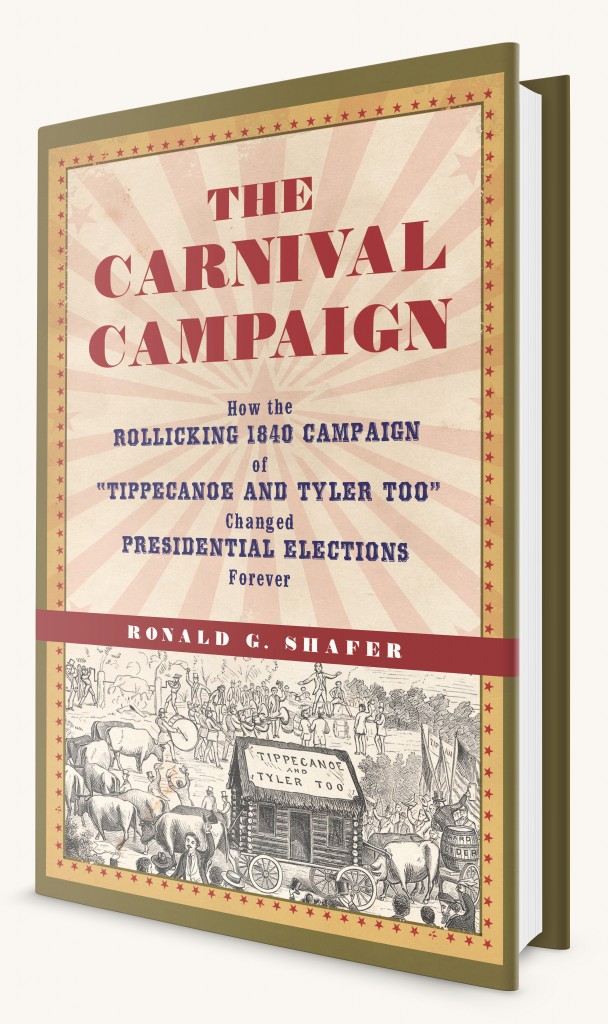 In 1840, Americans were largely unhappy and unemployed, fighting their way back from an economic slump and ready for a fresh face in the White House. Along came William Henry Harrison, a former general of great wealth and power who portrayed himself—with the help of his Whig Party colleagues—as an everyman living in a log cabin, drinking cider. He promised government reform and smeared incumbent president Martin Van Buren as an elitist dandy out of touch with the people, and his in-person appearances at grassroots rallies around the country wound up drawing tens of thousands who zealously parroted his campaign catchphrases while parading about, pulling floats and playing music. Is any of this starting to sound familiar? In his new book, The Carnival Campaign: How the Rollicking 1840 Campaign of “Tippecanoe and Tyler Too” Changed Presidential Elections Forever, author Ronald G. Shafer digs deep into the circus-like atmosphere surrounding the 1840 presidential race to identify its influences on the mudslinging spectacle that is the modern election cycle. Below, he talks about how he came to write the book and how Harrison’s campaign would fare here in 2016.
In 1840, Americans were largely unhappy and unemployed, fighting their way back from an economic slump and ready for a fresh face in the White House. Along came William Henry Harrison, a former general of great wealth and power who portrayed himself—with the help of his Whig Party colleagues—as an everyman living in a log cabin, drinking cider. He promised government reform and smeared incumbent president Martin Van Buren as an elitist dandy out of touch with the people, and his in-person appearances at grassroots rallies around the country wound up drawing tens of thousands who zealously parroted his campaign catchphrases while parading about, pulling floats and playing music. Is any of this starting to sound familiar? In his new book, The Carnival Campaign: How the Rollicking 1840 Campaign of “Tippecanoe and Tyler Too” Changed Presidential Elections Forever, author Ronald G. Shafer digs deep into the circus-like atmosphere surrounding the 1840 presidential race to identify its influences on the mudslinging spectacle that is the modern election cycle. Below, he talks about how he came to write the book and how Harrison’s campaign would fare here in 2016.
As a former newspaper journalist, you’ve done a fair amount of reporting on various historical and contemporary political scenes. How did you first become interested in the story of the 1840 presidential election in particular?
As a reporter and editor at the Wall Street Journal for 38 years, I attended at least one of the presidential conventions from 1976 through 2000. Contrary to the belief of some of my younger friends, I did not personally cover the 1840 campaign. When I was the Journal’s Washington political features editor, I always heard that the 1840 race of “Tippecanoe and Tyler Too” was the first modern presidential campaign. But I never could find much written about it.
When did you decide the subject was worth writing a book about?
I began researching the 1840 campaign in Washington soon after I retired in 2001. But it was still the digital dark ages. In order to read a key document, the Log Cabin newspaper of 1840, you had to go to the Library of Congress, where they would bring out a fragile original copy for you to gingerly read with rubber gloves only at the library. Access to other old documents and books was also difficult. My interest was revived when I moved to Williamsburg, Virginia, seven years ago. I visited the nearby boyhood home of 1840 Whig candidate William Henry “Old Tippecanoe” Harrison and later got a personal tour of President Tyler’s nearby retirement home by his great-grandson.
In the back of The Carnival Campaign, you thank a number of historical sites, societies, and museums. How extensive was the research process for this book? What were the most valuable resources you came across?
I researched the book for about two years. The most valuable finds were that the Log Cabin newspaper now was digitized—so that I could easily read every issue. Also online, on Google Books, were numerous books written in the 1800s by eyewitnesses to the 1840 campaign, including one by one of the two men who created the campaign’s “Log Cabin and Hard Cider” theme at a mansion in Harrisburg, Pennsylvania. It’s not often that you can be “in the room” when something historic is created.
You describe William Henry Harrison’s grassroots campaign rallies as carnival-like affairs with floats and food and music. What were some of the most elaborate or festive scenes or details you discovered during your research?
Until 1840, presidential campaigns were fairly staid affairs with citizen meetings, a few torchlight parades and letters written by the candidates, who never campaigned publicly. The Whigs organized monstrous parades, complete with log cabins on wheels, marching bands and tons of food. The goal was to create a fun atmosphere to entertain and influence voters who were in a funk because of an economic depression. It was party time in America, with the rallies regularly drawing more than 50,000 people.
How do you think Harrison’s campaign, stoked by his Whig Party–cultivated image as an everyman, would play out in the modern political and journalistic environment?
 Harrison’s image campaign as a poor man living in a log cabin would be in deep doo-doo in a 2016 race. 60 Minutes and other media investigators would be showing that he lived in a mansion and interviewing people who would reveal that the general didn’t even drink hard cider. Old Tippecanoe would be grilled on Meet the Press. Washington Post fact-checkers would be giving him four Pinocchios.
Harrison’s image campaign as a poor man living in a log cabin would be in deep doo-doo in a 2016 race. 60 Minutes and other media investigators would be showing that he lived in a mansion and interviewing people who would reveal that the general didn’t even drink hard cider. Old Tippecanoe would be grilled on Meet the Press. Washington Post fact-checkers would be giving him four Pinocchios.
What similarities do you see between Harrison’s campaign and those of Clinton and Trump?
Many voters then—like many today—didn’t really care much about facts; they were angry and just wanted change. The Whigs, like Donald Trump, promised to make America great again, though with the less-catchy slogan “Harrison and Reform.” The 1840 election, with politics as entertainment, blatant demagoguery and personal insults, was a forerunner of the Trump campaign of 2016. And, like Hillary Clinton, long before e-mail, Harrison had a mail scandal when it was discovered that some voters’ letters to him were instead answered by his campaign committee. Plus, the 67-year-old Harrison was derided as a granny while Hillary really is a granny—and Trump is a grandpa.
Is there any part of the modern presidential election cycle that you think the 1840 election directly influenced?
The most direct influence of the 1840 campaign was that Harrison became the first presidential candidate ever to give speeches. Previously, that had been considered highly improper. Even Old Tippecanoe worried that he might be setting a precedent that future candidates might follow. Boy, did he get that one right. The Whig rallies were the beginning of the campaign rallies that we see today—though usually without live eagles, the world’s tallest man and loaves of bread. Another lasting change begun in 1840 was the involvement of women in presidential politics; they couldn’t vote, but it was the first step toward the day when a woman could even run for president. Finally, Harrison’s image campaign solidified a campaign tactic that has been a staple of presidential candidates ever since. It is called lying. Some things never change.
-Geoff George
The Carnival Campaign officially pubs on September 1 and is available wherever books and e-books are sold.
1 Comment
[…] On the blog—Behind the Scenes with Ronald G. Shafer: Do you think the 2016 election is a circus? The 1840 origins of the modern presidential race […]